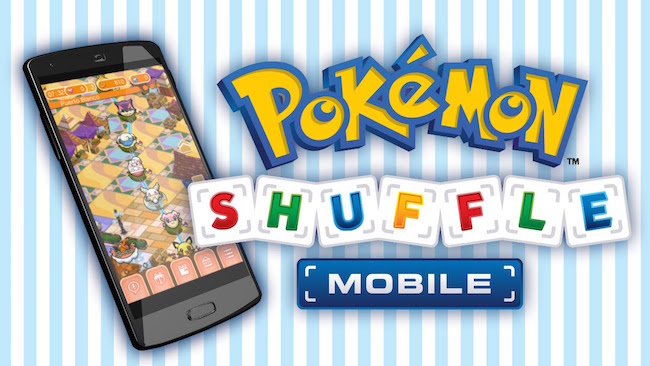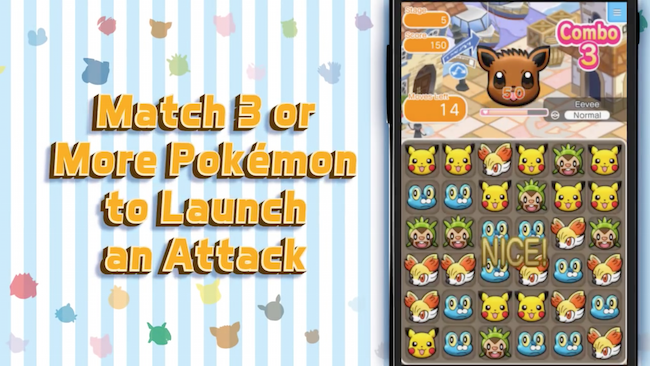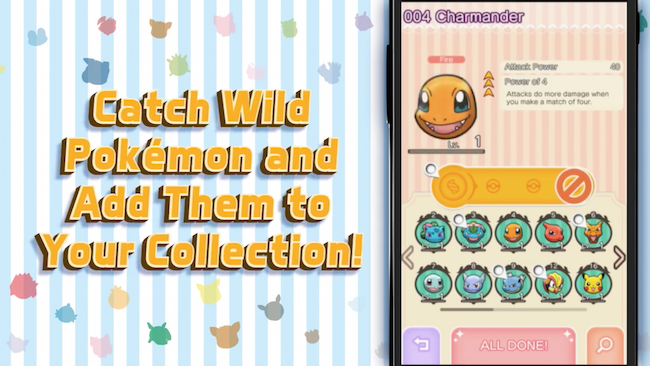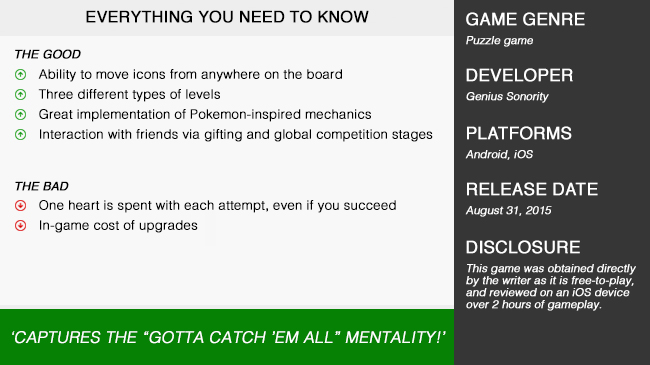
With the recent Pokémon GO announcement sending wannabe Pokémon trainers (i.e. every ’90s kid) into a frenzy, it seems only fitting to painstakingly examine every element of Nintendo’s first foray into mobile app gaming (Pokémon Shuffle) in order to better speculate about the success of the eagerly awaited future titles.
Let’s be honest, when you hear Nintendo is releasing a free Pokémon app game, it is only natural to feel excited. When you hear it is a free game with ‘in-app purchases,’ it is only natural for that excitement to turn to disappointment.
But don’t let your distaste for freemium app games colour your judgement of Pokémon spin-off games. If we look back at Nintendo’s history, there are a number of spin-off titles that do the Pokémon franchise justice- Pokémon Puzzle Challenge, Pokémon Ranger and Mystery Dungeon just to name a few. Could Pokémon Shuffle be the next big name Pokémon game and a positive precursor to the further 4 mobile games Nintendo intend to launch over the next 2 years?
No. And Yes. Let me explain.

This game is essentially Candy Crush (in a new skin) with the time-sensitive elements that made FarmVille so addictive in its hay-day. Did anyone else ever set an alarm to wake up at 3 am for optimal crop harvesting? (Ok, maybe that was just me…) Admittedly, here, there are some differences in gameplay inspired by the core mechanics of Pokémon battles, but the overall feel is saga-esque, and this game adds nothing groundbreaking to the world of mobile gaming.
And yet, there is something inexplicably compelling about Pokémon Shuffle.
Continuing with Nintendo’s recent move to European-inspired settings for the Pokémon franchise (see: Le Pokémon X and Y), Pokémon Shuffle is initially set in Puerto Blanco- a Spanish-themed seaside town. The formulaic in-game tutorial is delivered across the first few stages by a cheerful female reporter, and the learning curve is well paced.
The aim of each stage is to defeat the Pokémon that represents that stage, in what can only be described as a pseudo-Pokémon battle. Similarly to Candy Crush, players do this by creating enough vertical or horizontal matches of 3 or more of the same icons, within a certain number of turns. Unlike in Candy Crush, an icon can be moved from anywhere on the board to make a match. The icons represented in each stage are the heads of the Pokémon you have decided to take into the battle. As the classic concepts of weakness and resistance apply, it is important to strategically select the Pokémon in your party. Experience points and leveling up are also concepts transferred from the main title games so it is important to give all your Pokémon opportunities to battle so they have the chance to grow in strength.
When a stage is successfully completed, players have the opportunity to catch the defeated Pokémon using a Pokeball. The chance of catching the Pokémon (represented as a percentage) seems to be random but is always increased if the stage is completed with many turns remaining. The chance of capture can also be increased by purchasing a Great Ball through coins (which can be bought or painstakingly earned in-game). If a Pokémon is successfully captured, it is added to your collection and you can take it with you to battles!

APPealing aspects: A change of scenery and music to reflect the new elemental type of Pokémon after every 10-15 stages are cleared, combined with the Pokémon leveling aspect, gives a sense of narrative progression often missing in arcade-style app games.
Clearing stages also unlocks ‘Special’ and ‘Expert’ levels, which provide an alternative play path and allow access to exclusive Pokémon- including legendaries. Special Pokémon are only available for a certain amount of time- adding a sense of urgency to training and leveling up your Pokémon. Within the ‘Special’ level, there is also a Competition stage, which ranks players around the world against each other, with the highest scoring players receiving exclusive Pokémon and prizes.
APPauling aspects: The ‘regenerating health’ mechanic is one overwhelming negative design aspect that detracts from the Shuffle experience. Players begin the game with five hearts, with one heart being expired every time a stage is attempted; regardless of whether or not the attempt was a success. This limits the number of consecutive games played to five until a heart is recharged (30 minutes per heart). Hearts can be bought using Jewels (another area where the game demonstrates it’s “freemium-ness”) or received from friends once per day through Facebook.
APPathetic about: A move guide appears every time you hesitate for a split second during a stage. While helpful during the tutorial stages, the yellow boxes suggesting a potential move are much more of a distraction once you’ve mastered the basics of the game. In addition, the graphic presentation of the Expert and Special levels is not that inspired.

All things considered, Pokémon Shuffle is a game worth including in your app collection. The variety of levels and novel approach to icon movement helps to keep the match-3 genre fresh and interesting. In particular, Pokémon fans with a “gotta catch ‘em all” mentality will lap up this old school spin (dare I say, shuffle) on the now classic mobile gaming formula but seasoned saga enthusiasts will struggle with the ‘cost’ associated with simply attempting a level. Ultimately, I can’t decide whether this is a promising (albeit conservative) or concerning start to Nintendo’s Pokémon app gaming future. A part of me feels that Nintendo might be using Pokémon Shuffle to gauge how far they can push microtransactions in their future titles.











